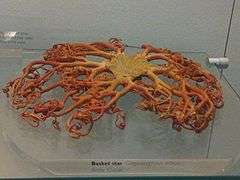Gorgonocephalus arcticus
Gorgonocephalus arcticus is a species of basket star in the class Ophiuroidea. The genus name comes from the Greek, gorgós meaning "dreaded" and cephalus meaning "head", and refers to the similarity between these echinoids and the Gorgon's head from Greek myth with its coiled serpents for hair.[2] This species is also able to live non parasitically on the exterior of other sessile animals while it continues to grow.[3] G. arcticus have been observed living on the exterior of Boltenia ovifera, a species of tunicates found in a similar range of the Arctic to Cape Cod.[3] This species is found in varying depths in the water column, from as shallow as the sublittoral zone to a maximum depth of 1500 m.[3] Their feeding mechanism has been extensively studied in the wild and in captivity.[3]
| Gorgonocephalus arcticus | |
|---|---|
 | |
| Gorgonocephalus arcticus | |
| Scientific classification | |
| Kingdom: | |
| Phylum: | |
| Class: | |
| Order: | |
| Suborder: | |
| Family: | |
| Genus: | |
| Species: | G. arcticus |
| Binomial name | |
| Gorgonocephalus arcticus Leach, 1819 | |
| Synonyms[1] | |
| |
Morphology
Roughly 9.5 percent of their skeletons are composed of magnesium carbonate.[4] This species is a suspension feeder and feeds by extending its arms vertically into the water column in search of plankton.[3] Like other members of the Echinoderm taxa, five arms extending from a central disc.[2] The arms branch off into smaller and smaller subdivisions.[2] The calcified ossicle endoskeleton of calcified is covered by a fleshy skin, which gives them a rubbery appearance.[2]
Feeding
Unlike other observed basket stars that only feed at night, G. arcticus was observed feeding by day.[3] This act of actively extending their arms into the water column does not make them passive consumers of plankton; they also are able to actively trap prey.[3] G. arcticus populations are distributed from the Arctic to Cape Cod, Massachusetts.[3] Gorgonocephalus arcticus is associated with dwelling on hard substrates and create islands of similar hard substrate fauna when surrounded by unsuitable sandy substrates such as in the Fiords surrounding Baffin Island in Canada. For larger particles, G. arcticus stars wave the tips of their outstretched arms to catch plankton in the current by entangling them in rings of hooks that encircle the arms.[3] Once the arms come into contact with these larger plankton, they curled inwards to further ensnare the prey.[3] The direct response to the stimulus of a prey item is for the coiling of the arm that come into contact with the prey while other nearby tendrils curve towards this arm to further trap the prey.[3] The upper extensions of the arms are more flexible than the lower parts of the extremities so they are more effective at ensnaring prey.[3] Basket stars like all other echinoderms have tube feet; however the tube feet did not seem to be involved in removing large plankton from the water for they only extend a short distance, approximately 1 mm, into the water column.[3] Tube feet along with girdle hooks and spines are used to move the captured particles towards the oral surface.[3] The girdle hooks are made of calcite and in reality are curved ossicles attached by ligaments to a boss suggesting that they are spines adapted to restrain prey items.[3] The entire length of the arm is covered in lateral spines that increase in size and number from the tip towards the base.[3] The spines are connected to ossicles by tendons.[3] Though there is no muscle tissue connected to the ligaments connecting the spines and girdle hooks their main purpose is hypothesized to help contain prey as the arm coils into a curl to bring the prey to the mouth.[3]
References
- Hansson, Hans (2004). "Gorgonocephalus arcticus Leach, 1819". WoRMS. World Register of Marine Species. Retrieved 16 October 2014.
- Mah, Christopher (26 January 2010). "GORGONOCEPHALUS!! Because Weird is what we do!". The Echinoblog. Retrieved 16 October 2014.
- Emson, Roland (1991). "The feeding mechanism of the basket star Gorgonocephalus arcticus". Canadian Journal of Zoology. 69: 449–455. doi:10.1139/z91-070.
- Clarke, Frank Wigglesworth (1915). The Inorganic Constituents of Echinoderms. US Government Printing Office. pp. 1–9. OCLC 19792067.